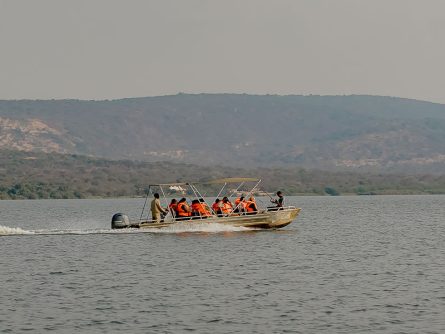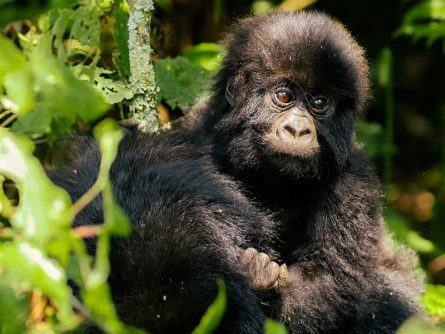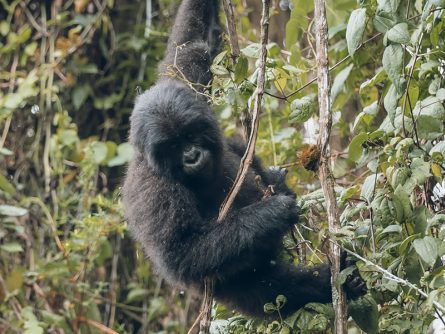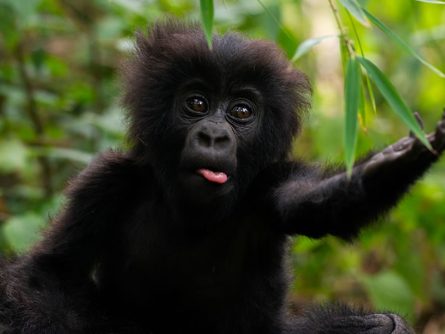Located in the southwest of Rwanda, Nyungwe Forest National Park is a treasure trove of natural beauty and wildlife. As one of Africa’s oldest rainforests, it offers travelers a unique opportunity to explore a world filled with rich biodiversity and stunning landscapes. Spanning over 1,000 square kilometers, this lush green sanctuary is more than just a place of beauty: it’s vital for the region, serving as a crucial water source for both the Nile and Congo rivers. For anyone looking to connect with nature while experiencing adventure and peace, Nyungwe is the perfect destination.
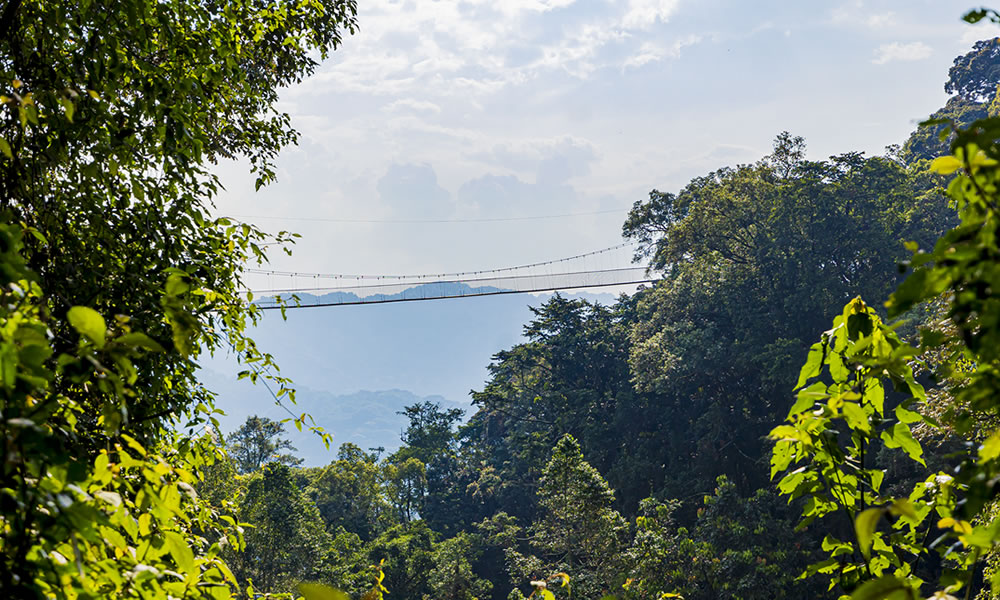
Wildlife You’ll Encounter in Nyungwe Forest
Nyungwe is a paradise for wildlife enthusiasts. Its dense, pristine forest is home to over 13 species of primates, each adding to the magic of the park. The stars of the show are the chimpanzees around 500 of them roam the forest. Tracking these intelligent, lively creatures is one of the park’s top highlights, giving visitors an unforgettable experience as they observe chimpanzees playing, swinging through trees, or grooming each other.
But chimpanzees aren’t the only primates that call Nyungwe home. You’ll also come across L'Hoest's monkeys, black-and-white colobus monkeys, golden monkeys, and the cheeky vervet monkeys. Each species brings its own charm and sense of wonder to your adventure.
If you’re a bird lover, Nyungwe will feel like paradise. With over 320 bird species, including 29 that are found only in this part of the world (the Albertine Rift), the park is a dream for birdwatchers. You might spot the striking great blue turaco, the colorful Rwenzori turaco, or the rare Rockefeller’s sunbird. Whether you’re an avid birder or just curious, the vibrant birdlife is sure to catch your eye.
In addition to primates and birds, the park is home to a variety of other fascinating creatures. You may see servals gracefully stalking through the underbrush or catch a glimpse of a mongoose darting across the trail. And while elusive, the presence of leopards adds a thrill to every exploration. The park’s thick forest, swamps, and bamboo groves also house a variety of reptiles and amphibians, making Nyungwe a true biodiversity hotspot.
Visiting Nyungwe isn’t just about seeing wildlife; it’s about immersing yourself in a living, breathing ecosystem where every step unveils something extraordinary.
ACTIVITIES IN NYUGWE FOREST NATIONAL PARK
Nyungwe Forest National Park is not only a sanctuary for diverse wildlife, but it also offers an array of exciting activities that allow visitors to experience the park’s natural beauty and cultural heritage up close. From primate trekking to immersive cultural encounters, there’s something for everyone.
- Chimpanzee Trekking in Nyungwe Forest National Park
Imagine stepping into the heart of one of Africa’s most ancient rainforests at dawn, with the morning mist still hanging in the air and the forest alive with the sounds of nature waking up. This is the start of a chimpanzee trekking adventure in Nyungwe Forest National Park, a thrilling experience that offers a rare chance to see our closest relatives in the wild.
Nyungwe is home to over 500 chimpanzees, making it one of the best places in East Africa to witness these fascinating primates in their natural habitat. Whether you’re a wildlife enthusiast or just curious to observe these intelligent creatures up close, chimpanzee trekking promises a memorable encounter.
What to Expect from Chimpanzee Trekking in Nyungwe Forest National Park
Your day begins early, often before the sun has fully risen. After gathering at the park headquarters, you’ll receive a briefing from experienced guides who know the forest and its inhabitants intimately. They’ll explain what to expect during the trek, how to behave around the chimpanzees, and how best to enjoy this unique experience.
Once you enter the forest, the excitement builds as your guide helps you spot signs of the chimpanzees’ presence. You’ll find yourself walking along trails lined with towering trees and dense vegetation. Every now and then, the guide might point out fresh chimpanzee nests or the sound of distant calls a sign that the troop is nearby.
And then, the moment arrives: you finally spot the chimps. You watch in awe as they swing effortlessly through the trees, groom each other, or search for food. It’s a deeply moving experience seeing these animals up close, noticing how their behavior mirrors our own in so many ways. You’ll have about an hour to observe the chimpanzees, but those 60 minutes feel magical. Whether they’re playing, communicating with their unique calls, or simply lounging in the trees, you get to witness the social dynamics of the group and see just how intelligent and human-like they are.
Why Chimpanzee Trekking is Special in Nyungwe Forest National Park
Chimpanzee trekking isn’t just about spotting wildlife, it’s about being immersed in the sights, sounds, and smells of a forest that’s teeming with life. You’ll likely encounter other species of primates, such as colobus monkeys or L’Hoest’s monkeys, and the birdlife in Nyungwe is equally astounding. The forest itself is a wonder, with its thick canopy, giant ferns, and streams winding through the landscape.
The experience is guided by expert trackers who bring the forest to life. They’ll share fascinating insights about chimpanzee behavior, pointing out subtle details that you might otherwise miss. Their passion and knowledge add another layer of appreciation for the wonders of Nyungwe.
When to Go for Chimpanzee Trekking in Nyungwe Forest National Park
While chimpanzee trekking in Nyungwe is available year-round, the best time to visit is during the dry seasons, from June to September or December to February. The trails are easier to navigate, and the chances of encountering the chimpanzees increase. That said, the forest is beautiful in the rainy season too—lush and vibrant, though the trek can be a bit more challenging due to the wet and muddy conditions.
Tips for Your Trek in Nyungwe Forest National Park
- Stay Fit
The trek can range from easy to challenging, depending on where the chimps are located that day. It’s important to be reasonably fit, as you might hike through steep and sometimes muddy terrain for several hours.
- Dress Smart
Long sleeves and pants are a must to protect you from forest insects, and sturdy hiking boots with good grip are essential, especially if you visit during the rainy season.
- Pack the Essentials
Bring a rain jacket; it’s a rainforest, after all, and you never know when a downpour might hit. If you enjoy photography or bird watching, a good zoom lens and binoculars will enhance your experience.
- Respect the Chimps
While it’s thrilling to be close to the chimpanzees, always maintain a respectful distance (at least 8 meters) and follow the guidelines from your guide to ensure both your safety and the chimps' well-being.
Costs and Booking for Chimpanzee Trekking in Nyungwe Forest National Park
Chimpanzee trekking requires a permit, which can be arranged through the Rwanda Development Board or tour operators. While it’s an investment, it’s one that rewards you with memories you’ll cherish forever. The cost is also typically more affordable than gorilla trekking, making it a great option for travelers wanting to experience Rwanda’s primates.
Chimpanzee trekking in Nyungwe Forest isn’t just an activity, it’s an adventure that takes you deep into the heart of one of Africa’s most remarkable ecosystems. It’s an opportunity to connect with nature and witness some of the most intelligent creatures on the planet, all while surrounded by the serenity of the forest. Whether you’re an avid wildlife lover or a first-time visitor, this experience is one that will stay with you long after you’ve left the forest behind.
- Canopy Walk in Nyungwe Forest National Park: A Bird’s-Eye Adventure
Imagine walking high above the treetops, surrounded by the sounds of birds calling and leaves rustling in the wind, as you take in breathtaking views of one of Africa’s most ancient rainforests. This is the magic of the Canopy Walk in Nyungwe Forest National Park, an exhilarating and awe-inspiring experience that offers visitors a chance to see the forest from a whole new perspective.
The Canopy Walk, the only one of its kind in East Africa, is suspended 50 meters above the forest floor and stretches for 160 meters. Whether you’re a nature lover, adventurer, or photographer, the walk is sure to be a highlight of your time in Nyungwe.
The Journey to the Canopy in Nyungwe Forest National Park
Your adventure begins with a guided hike through the lush rainforest. As you walk, your guide will point out the rich biodiversity around you, everything from towering trees and giant ferns to colorful birds flitting through the branches. You might even catch a glimpse of a playful troop of colobus monkeys or hear the distant call of chimpanzees echoing through the trees.
After about 30 to 45 minutes of hiking, you’ll arrive at the start of the canopy walkway. There’s a buzz of excitement as you step onto the bridge, which sways gently beneath your feet. Looking down, you realize just how high up you are, with the dense forest canopy stretching out below you. It’s both thrilling and humbling to be surrounded by such natural beauty, with nothing but treetops and sky as far as the eye can see.
Highlights of the Canopy Walk in Nyungwe Forest National Park
- Bird’s-Eye View of the Forest
From the canopy walkway, you’ll have an incredible perspective of the forest that few people get to see. The towering trees, the verdant greenery, and the sounds of wildlife all blend together to create a magical experience. You’ll feel completely immersed in nature, high above the forest floor.
- Wildlife Spotting
While on the Canopy Walk, you might spot a variety of wildlife, including different species of primates like the black-and-white colobus monkey. Nyungwe is also a bird-watcher’s paradise, and from the treetops, you’ll have the opportunity to spot some of the park’s 322 bird species, including Albertine Rift endemics like the Ruwenzori turaco.
- Thrilling Adventure
The Canopy Walk isn’t just about sightseeing, it’s also an exhilarating adventure. The height and gentle sway of the walkway can be a bit of a thrill for those who enjoy a little adrenaline with their nature experiences.
- Photography Opportunities
The panoramic views from the walkway offer fantastic opportunities for photography. Whether you’re capturing the vast rainforest stretching out beneath you or focusing on the smaller details like orchids and epiphytes growing in the treetops, the Canopy Walk provides a unique vantage point for stunning shots.
Thrill Meets Tranquility in Nyungwe Forest National Park
The Canopy Walk isn’t just about the views, it’s also an adventure. The height and gentle sway of the bridge can be thrilling, adding a touch of excitement to the peaceful experience of being surrounded by nature. But even if you’re not a thrill-seeker, the walk feels serene. The air is fresh, the surroundings peaceful, and the only sounds are those of the forest: the rustling of leaves, the calls of birds, and the distant murmur of wildlife.
When to Visit Nyungwe Forest National Park for a Canopy Walk
While the Canopy Walk is open year-round, the dry seasons “June to September and December to February” are ideal for this experience. The weather is generally more predictable, and the trails leading to the walkway are easier to navigate. However, even in the rainy season, the forest takes on a lush, magical quality that can make the walk just as memorable (though a bit muddier!).
Helpful Tips for Your Canopy Walk in Nyungwe Forest National Park
- Be prepared for a hike
The trek to the Canopy Walk is moderately challenging, so it’s important to be in reasonable shape. The forest floor can be uneven, and you might need to navigate a few steep sections, but the reward is worth every step.
- Dress for the forest
Make sure to wear comfortable hiking shoes with a good grip. Long sleeves and pants will protect you from insects, and don’t forget a rain jacket in case of unexpected showers—it’s a rainforest, after all.
- Take it slow
Don’t rush through the experience. Stop along the way to take in the views, listen to the sounds of the forest, and truly appreciate being in such a special place.
- Capture the moment
If you love photography, bring a camera or smartphone to capture the stunning views from above. A wide-angle lens is great for sweeping shots, while a zoom lens will help you capture details like birds or distant mountains.
Why You Shouldn’t Miss The Canopy Walk in Nyungwe Forest National Park
The Canopy Walk is more than just a fun activity; it’s a chance to experience the forest in a way few people ever get to. It’s about connecting with nature, feeling a sense of awe and adventure, and taking in the beauty of Rwanda’s rainforests from an unforgettable perspective.
Whether you’re exploring Nyungwe for its wildlife, seeking an adrenaline-filled adventure, or simply looking to enjoy the tranquility of the forest, the Canopy Walk offers something for everyone. It’s an experience that will leave you with lasting memories, and a deep appreciation for the wonders of the natural world.
- Bird Watching in Nyungwe Forest National Park: A Paradise for Bird Lovers
If you’re a bird lover, Nyungwe Forest National Park in Rwanda will feel like a dream come true. With its dense rainforest and diverse landscapes, this park is one of the best places in Africa to go bird watching. Imagine wandering through lush green forests, surrounded by the sounds of chirping birds, rustling leaves, and the occasional flutter of wings overhead. Nyungwe is home to over 322 bird species, including 29 that are found nowhere else but the Albertine Rift. Whether you’re an experienced birder or just someone who enjoys being in nature, Nyungwe offers a bird-watching experience that will stay with you long after you leave.
A Bird-Watcher’s Haven
Nyungwe’s bird species are as diverse as its landscapes. Among the park's highlights are its population of Albertine Rift endemics, many of which are rare and hard to spot elsewhere. These birds thrive in Nyungwe’s unique environment, making it a hotspot for those seeking out rare species.
Some of the standout birds you might encounter include:
- Great Blue Turaco
This striking bird is one of the stars of Nyungwe. With its vivid blue, green, and yellow plumage, it’s hard to miss. You’ll often see them flying gracefully between the trees, their large size and bright colors making them easy to spot.
- Ruwenzori Turaco
A true gem for bird watchers, the Ruwenzori Turaco is found only in the Albertine Rift. Its beautiful green and crimson feathers make it one of the park’s most sought-after sightings.
- Red-Collared Mountain Babbler
This bird is rarer to find, but for dedicated birders, spotting one is a real treat. Its soft but distinct colors blend into the forest, making it a rewarding challenge to see.
- Rockefeller’s Sunbird
Known for its brilliant iridescent feathers, Rockefeller’s Sunbird is one of Nyungwe’s many small, energetic sunbirds that zip around the forest looking for nectar.
- Albertine Owlet
If you’re lucky, you might catch a glimpse of this elusive little owl. Found only in the Albertine Rift, it’s one of Nyungwe’s most exciting finds for serious bird watchers.
Best Bird-Watching Trails in Nyungwe Forest National Park
To truly experience the rich birdlife of Nyungwe, there are several trails that offer a mix of habitats and bird species. Whether you want a gentle walk or a more adventurous hike, there’s a trail for you:
- Karamba Birding Trail
This is one of the top birding spots in the park. Once a gold mining area, it’s now a perfect place to watch birds like the Mountain Buzzard and White-headed Wood Hoopoe. The open spaces here make it easier to spot birds in flight.
- Bigugu Trail
If you’re up for a challenge, the Bigugu Trail takes you to the highest point in the park, at nearly 3,000 meters. Along the way, you’ll come across species that prefer these high-altitude habitats.
- Ngabwe Trail
This trail takes you through thick forest and along the forest’s edge, where you can see both canopy birds and those that live in the undergrowth. It’s a great place to enjoy a variety of bird species in one walk.
- Kamiranzovu Marsh Trail
A completely different birding experience, this trail leads to a large wetland where water-loving birds like the Grey Crowned Crane and Grauer’s Swamp Warbler can often be seen.
Guided Bird Watching Tours in Nyungwe Forest National Park
One of the best ways to enjoy bird watching in Nyungwe is by joining a guided tour. Local guides know the forest inside out, and they have a special talent for spotting birds that are well-camouflaged in the trees. They’ll also help you learn to recognize bird calls and share fascinating stories about each species.
Tours usually start early in the morning when the birds are most active. Depending on how deep into the forest you want to go, tours can last half a day or a full day. You’ll have plenty of chances to stop, listen, and watch as the forest wakes up around you.
Best Time for Bird Watching in Nyungwe Forest National Park
Bird watching in Nyungwe is great all year, but the dry seasons from June to September and December to February are the best times to visit. During these months, the trails are easier to navigate, and the weather is more predictable. If you visit during the rainy season, the forest will be even more lush and green, though the trails can get muddy. Either way, you’re sure to see plenty of birds.
Tips for a Great Bird-Watching Experience in Nyungwe Forest National Park
- Bring binoculars
To fully enjoy bird watching, a good pair of binoculars is essential. Birds often perch high in the treetops, and binoculars will help you see them clearly.
- Dress for the forest
Wear comfortable clothes in neutral colors so you blend in with the surroundings. Long sleeves and pants will also help protect you from insects.
- Be patient
Bird watching is all about taking your time. Move quietly, listen for bird calls, and be prepared to wait for the birds to reveal themselves.
- Bring a field guide
A birding guidebook for Rwanda or East Africa will help you identify the different species you see. Your guide will also be a great resource for learning more about each bird.
Why Bird Watching in Nyungwe Forest National Park is Special
Nyungwe isn’t just a place to check birds off your list, it’s a place to connect with nature. As you walk through the forest, listening to the sounds of birds calling to one another and watching them flit from tree to tree, you’ll feel a sense of wonder and peace. The beauty and diversity of the birds here make every moment magical, whether you’re spotting a rare Albertine endemic or watching a Great Blue Turaco soar through the trees.
For anyone who loves nature, Nyungwe Forest National Park offers an unforgettable bird-watching experience. It’s a chance to slow down, take in the beauty of the forest, and discover some of the rarest and most beautiful birds in Africa.
- Nature Walks and Hiking in Nyungwe Forest National Park: A Journey into the Heart of Nature
Nyungwe Forest National Park is a hiker’s paradise, offering over 130 kilometers of well-maintained trails that meander through one of Africa’s oldest rainforests. With its stunning landscapes, towering trees, and abundant wildlife, Nyungwe is a dream for anyone who loves nature and outdoor adventure. Whether you're looking for a short stroll to soak in the beauty of the forest or a more challenging trek to discover hidden waterfalls and sweeping mountain views, Nyungwe’s hiking and nature walks cater to all levels of fitness and interest.
What Makes Nyungwe’s Trails Special?
The best part about hiking in Nyungwe is the diversity of experiences. You’ll pass through different habitats as you walk, each offering something new. One minute, you might be in the shade of the rainforest, surrounded by giant ferns and ancient trees. The next, you’re catching a glimpse of a waterfall, listening to the calming sound of water rushing over rocks. Wildlife is everywhere, if you keep your eyes open, you might spot a troop of colobus monkeys, a colorful bird flitting through the trees, or even hear the calls of chimpanzees in the distance.
Hiking Trails in Nyungwe Forest National Park
Whether you’re a casual walker or an experienced hiker, Nyungwe’s trails cater to all levels. Here are a few of the park’s top trails:
- Igishigishigi Trail
Distance: 2.1 km
Time: 1.5 hours
Difficulty: Easy
If you’re looking for a gentle introduction to Nyungwe’s beauty, the Igishigishigi Trail is perfect. It’s a short and easy trail that takes you through lush forest and leads to the famous Canopy Walk, where you can get a bird’s-eye view of the treetops. You’ll be surrounded by the sounds of birds and might spot monkeys playing in the trees.
- Bigugu Trail
Distance: 10.6 km
Time: 6 hours
Difficulty: Moderate to Difficult
For a more challenging adventure, the Bigugu Trail takes you to the highest peak in Nyungwe, Bigugu Mountain. It’s a tough hike, but the reward is stunning panoramic views of the park’s rolling hills and valleys. Along the way, you’ll see a mix of landscapes, from forest to open meadows, and have a good chance of encountering some of Nyungwe’s wildlife.
- Kamiranzovu Marsh Trail
Distance: 6 km
Time: 3 hours
Difficulty: Moderate
If you enjoy exploring different ecosystems, this trail takes you to Nyungwe’s largest wetland, Kamiranzovu Marsh. It’s a peaceful hike where you can see water-loving plants and birds, including the elegant Grey Crowned Crane. The marsh is a quiet, serene spot that feels like a hidden gem in the heart of the forest.
- Isumo Waterfall Trail
Distance: 10.6 km
Time: 4 hours
Difficulty: Moderate
The Isumo Waterfall Trail is one of the park’s most scenic routes, leading you to the spectacular Isumo Waterfall. The hike takes you through forest paths, past tea plantations, and across valleys where you can enjoy great views. When you reach the waterfall, the cool spray of water and the lush greenery around it make for a perfect spot to relax.
- Ngabwe Trail
Distance: 4.7 km
Time: 3 hours
Difficulty: Moderate
For a shorter hike with beautiful views, the Ngabwe Trail is ideal. It takes you through the forest and leads to a lovely picnic area where you can take a break and enjoy the sights and sounds of Nyungwe’s hills and valleys. It’s a peaceful walk, perfect for those looking to connect with nature.
- Congo Nile Divide Trail
Distance: 42 km
Time: 3 to 4 days
Difficulty: Difficult
For serious hikers, the Congo Nile Divide Trail offers an unforgettable multi-day trek. This long trail follows the ridge between the Congo and Nile river basins, giving you dramatic views of both sides. It’s a challenging hike, but you’ll pass through some of Nyungwe’s most remote and beautiful areas, with plenty of opportunities to see wildlife along the way.
Wildlife Along the Trails in Nyungwe Forest National Park
One of the joys of hiking in Nyungwe is the chance to encounter its incredible wildlife. As you walk, you might spot playful black-and-white colobus monkeys swinging from the trees or catch a glimpse of a shy L’Hoest’s monkey. Birdwatchers will be in heaven, as the forest is home to over 300 bird species, including many that are found only in this region. Keep an eye out for the Great Blue Turaco with its striking colors, or the Albertine Owlet, a rare find for keen birders.
Guided Nature Walks in Nyungwe Forest National Park
If you really want to get the most out of your hike, joining a guided nature walk is the way to go. The park’s guides are incredibly knowledgeable and can point out the plants, animals, and natural features that you might otherwise miss. They’ll tell you about the forest’s history, its importance to the local people, and share fascinating stories about the wildlife that calls Nyungwe home.
When to Go Hiking in Nyungwe Forest National Park
The best time to hike in Nyungwe is during the dry seasons, from June to September and December to February. The weather is more predictable, and the trails are less muddy, making for an easier and more enjoyable experience. However, if you don’t mind a bit of rain, the wet season brings its own magic. The forest becomes even more lush and green, and the waterfalls are at their most powerful.
Why You’ll Love Hiking in Nyungwe Forest National Park
Hiking in Nyungwe Forest is more than just a physical activity, it’s an immersive journey into one of Africa’s most beautiful and diverse rainforests. Whether you’re walking through the mist-covered trees, listening to the birds sing, or marveling at the views from a mountaintop, every moment in Nyungwe feels special. For nature lovers, there’s no better place to reconnect with the outdoors and experience the wonders of Rwanda’s natural beauty.
- Cultural Encounters in Nyungwe Forest National Park: A Glimpse into Rwanda’s Rich Heritage
Nyungwe Forest National Park is not just about its breathtaking wildlife and lush landscapes, it’s also surrounded by communities rich in culture and history. Engaging in a cultural encounter during your visit to Nyungwe offers a unique opportunity to connect with the local people, learn about their traditions, and gain a deeper appreciation for the region’s heritage.
The People and Traditions in Nyungwe Forest National Park
The communities living around Nyungwe have a long-standing connection to the forest. For generations, they have relied on it for sustenance, using its resources for medicine, food, and cultural practices. Today, cultural encounters allow visitors to experience firsthand the traditions and daily life of these local communities, who are eager to share their stories and skills.
What to Expect During a Cultural Encounter in Nyungwe Forest National Park
- Traditional Dance and Music Performances
One of the highlights of a cultural encounter is witnessing the vibrant music and dance that form an integral part of Rwandan culture. Local dance troupes perform traditional dances, often accompanied by drumming, singing, and chanting. The energy and rhythm of the performances are captivating, and visitors are often invited to join in the fun, learning a few dance steps or playing a drum.
- Visit to Tea Plantations
Tea is one of Rwanda’s most important exports, and the area surrounding Nyungwe is famous for its expansive tea plantations. A visit to a tea plantation offers insight into the process of tea production, from the picking of the leaves to their processing in the factory. You’ll learn about the labor-intensive work involved and how tea farming has shaped the livelihoods of local families. The lush green rows of tea bushes make for a picturesque setting, and visitors can even sample freshly brewed Rwandan tea.
- Handicrafts and Basket Weaving
The art of basket weaving is a treasured skill passed down through generations in the communities around Nyungwe. During your cultural encounter, you’ll have the chance to visit local artisans who create beautiful woven baskets using natural materials like sisal and papyrus. Watching the intricate process of basket weaving is fascinating, and you can try your hand at weaving under the guidance of an expert. The baskets are not only functional but also make for unique souvenirs to take home.
- Traditional Medicine and Herbal Healing
The people living near Nyungwe have long used the forest’s plants for medicinal purposes. On a cultural tour, you’ll meet traditional healers who are knowledgeable about the forest’s medicinal plants and their healing properties. These healers often share stories about how different plants are used to treat common ailments, and you’ll gain an understanding of the important role the forest plays in local health and well-being.
- Storytelling and Local Legends
Storytelling is an integral part of Rwandan culture, and during a cultural encounter, you’ll have the chance to hear local legends and folk tales passed down through generations. Elders in the community often take pride in sharing stories about the history of the region, the significance of the forest, and tales of bravery, love, and wisdom. These stories provide a rich context for understanding the deep cultural ties that exist between the people and the land.
- Village Walks and Community Interaction
Exploring the villages around Nyungwe on foot allows you to experience daily life up close. You’ll see how local families live, interact with friendly villagers, and perhaps even participate in traditional cooking or farming activities. These walks are a great way to learn about rural life in Rwanda and how communities are working to preserve their traditions while embracing sustainable tourism.
Why You Should Experience a Cultural Encounter in Nyungwe Forest National Park
A cultural encounter in Nyungwe Forest National Park provides a meaningful connection to the people who call this area home. It’s an enriching experience that goes beyond sightseeing, offering visitors a chance to learn, participate, and appreciate the vibrant culture that complements the natural beauty of the park. Through these interactions, you’ll not only gain a deeper understanding of Rwanda’s heritage but also support community-based tourism efforts that empower local people and help preserve their traditions for future generations.
Unique Features of Nyungwe Forest
- Biodiversity
Nyungwe Forest is an absolute treasure for nature lovers. It’s one of the most biologically rich rainforests in Africa, teeming with life at every turn. Because the forest sits at different altitudes, it creates a variety of little worlds, each filled with different species of plants, animals, and insects. Imagine walking through a living laboratory where over 1,000 plant species grow, many of which have been used for centuries by local communities as medicine. It's not just about plants though, the forest is home to 13 species of primates, including chimpanzees and the rare colobus monkeys, plus 322 types of birds, many found nowhere else but the Albertine Rift. Every step in Nyungwe is a chance to discover something extraordinary.
- Conservation Importance
Nyungwe is much more than a beautiful forest; it’s essential for the survival of millions of people across East Africa. This forest is a major source of water for both the Nile and Congo rivers, meaning it helps sustain entire ecosystems far beyond its borders. Protecting Nyungwe ensures that these vital watersheds remain intact, helping local communities and industries thrive. In addition, the forest plays a crucial role in fighting climate change by absorbing carbon dioxide. It’s not just a place for animals, Nyungwe is working hard to protect the environment and secure a better future for the region.
- Waterfalls and Scenic Beauty
Imagine hiking through a lush, green rainforest and suddenly coming upon a stunning waterfall, Nyungwe has plenty of these hidden gems, and Isumo Waterfall is one of the most beautiful. The journey to get there takes you through bamboo forests, across rolling hills, and past all kinds of plant life. When you finally reach the waterfall, the sight of water cascading down a rocky cliff, surrounded by rich vegetation, makes it all worth it. And it's not just the waterfalls, Nyungwe's landscape is rugged and wild, with deep valleys and towering peaks. Every hike or walk here comes with incredible views, offering a peaceful escape into nature’s wonderland.
Accommodation in Nyungwe Forest National Park
Nyungwe Forest offers accommodation for every kind of traveler, whether you’re seeking luxury or a more adventurous experience.
- One&Only Nyungwe House
If you’re in the mood for luxury, look no further than One&Only Nyungwe House. Tucked away on a tea plantation right next to the forest, this lodge has everything you need for a lavish stay, spa treatments, gourmet meals, and private guided tours through the forest. Imagine waking up to the sound of birds and the sight of mist rising over the tea fields and the forest beyond. It’s not just a place to stay; it’s an experience in itself, with every detail crafted to make your visit as comfortable and magical as possible.
- Nyungwe Top View Hill Hotel
For those looking for a balance between comfort and budget, Nyungwe Top View Hill Hotel offers cozy cottages perched on a hill with jaw-dropping views of the forest and surrounding mountains. It’s the perfect spot to relax after a day of adventure. You’ll love the friendly service, delicious local food, and the fact that you’re just a short drive away from all the park’s best activities, like chimpanzee trekking or the canopy walk. It’s a warm and welcoming home base for exploring the wonders of Nyungwe.
- Uwinka Campsite
For the more adventurous souls or travelers on a budget, the Uwinka Campsite is the perfect way to stay close to nature without breaking the bank. Set right inside the park, you’ll wake up to the sounds of the forest and maybe even catch sight of some wildlife nearby. It’s a rustic setup with basic facilities, but the beauty of being fully immersed in nature makes it worth it. If you want to experience Nyungwe in its raw, untouched form, camping here is the way to go.
Getting to Nyungwe Forest National Park
Nyungwe Forest National Park is just a 5-6 hour drive from Kigali, Rwanda’s capital. The journey is part of the adventure, with scenic views of Rwanda’s famous rolling hills, rural villages, and tea plantations along the way. If you’re pressed for time, you can catch a quick domestic flight to Kamembe Airport, which is only a short drive from the park. Whether you choose to drive or fly, the trip to Nyungwe is a picturesque experience that sets the stage for the adventures waiting in the forest.
Best Time to Visit Nyungwe Forest
Nyungwe is beautiful year-round, but the best time to visit is during the dry seasons, from June to September and December to February. These months offer easier hiking conditions, and the chances of spotting chimpanzees and other wildlife are higher, as they tend to stay closer to the ground. If you visit during the rainy seasons (March to May and October to November), the forest is even more lush and vibrant, though trails can be muddy. Either way, you’ll find Nyungwe to be a lush, enchanting place no matter the season.
Nyungwe Forest National Park is a must-visit destination for anyone who loves nature, adventure, and the beauty of the wild. Whether you’re trekking through the forest to spot chimpanzees, walking above the treetops on the canopy walk, or simply soaking in the peaceful surroundings, every moment here is an opportunity to connect with nature in a deeper way. It’s not just a park—it’s an experience that will leave you with memories to treasure for a lifetime.


